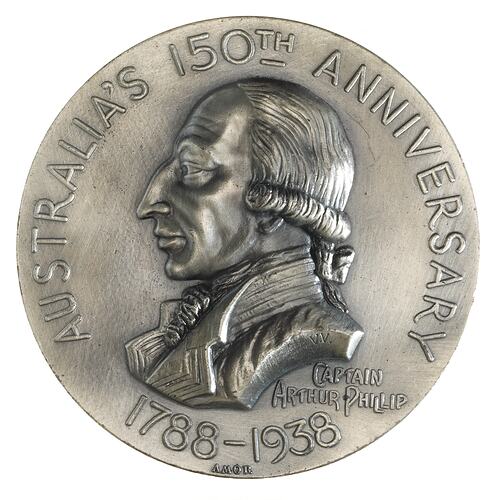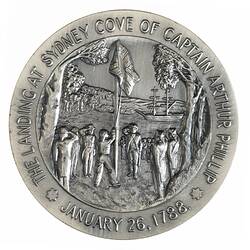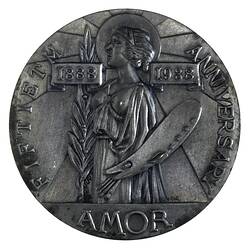Summary
Australia New South Wales Sydney
Landing of Governor Phillip at Sydney Cove 1788
Australia's 150 Anniversary 1938 (AD)
Mint: Amor
Other Details: This medal was struck in 1938 to commemorate the 150th anniversary of British settlement of Australia. It shows Captain Arthur Phillip, first governor of the colony of New South Wales and coordinator of the First Fleet. The obverse of the medal was engraved by Vanbola Veinberg, who came to Australia to work for the medal-maker Amor. The reverse was engraved by artist Charles Eccles.
Obverse Description
Bust of Captain Arthur Phillip head bare facing left, below in small letters, CAPTAIN / ARTHUR PHILLIP around, AUSTRALIA'S 150TH. ANNIVERSARY 1788 - 1938 Artist's initials, V.V., incuse on bust.
Reverse Description
At centre within wide rim the scene of the flag-raising with onlooking troops saluting; around on wide rim, THE LANDING AT SYDNEY COVE OF CAPTAIN ARTHUR PHILLIP * JANUARY 26, 1788 * Artist's initials, CE, at lower right of image.
Edge Description
Impressed SPECIMEN ONLY
Significance
Captain Arthur Phillip, first governor of the colony of New South Wales and coordinator of the First Fleet, was a career naval officer and a capable administrator in his first governing post. He was enthusiastic about the new colony, although did not want to see convicts 'lay the foundation of an Empire'. The First Fleet arrived in Botany Bay on 18 January 1788. Phillip enjoyed absolute powers in the colony, only accountable to the Colonial Secretary in England then to the Prime Minister and then to the King. He combined executive and legislative functions, and held the powers of the Chief Justice. He had complete authority over the inhabitants and the right to make regulations touching practically all aspects of their lives. He could also had the authority to grant land to approved persons. Phillip named and helped design Sydney and established Parramatta in 1788 for agricultural purposes. Parramatta soon became the main economic centre of the colony. Phillip established a clearing and building program and built the first government house. He was a firm but not harsh disciplinarian who rewarded signs of industry, but experienced a difficult relationship with his subordinate officers. He sought to persuade the Aboriginal population of the superiority of British civilization, while instituting the official British policy 'to endeavour to open intercourse' and to punish any person who 'interrupted' Aboriginal people. -Australian Dictionary of Biography. -D. Tout-Smith 27/11/2003.
More Information
-
Collecting Areas
-
Acquisition Information
Transfer from Melbourne Branch of Royal Mint, 11 Jan 1978
-
Date Issued
1938 AD
-
Issued By
-
Mint
-
Artist
Mr. Charles Eccles - Amor (Mint), Sydney, Greater Sydney, New South Wales, Australia, 1938
Signed reverse C.E. -
Artist
-
Person Depicted
Captain Arthur Phillip, Sydney, Greater Sydney, New South Wales, Australia, 1938
Scene of raising of flag in Sydney Cove 1788. -
Inscriptions
Impressed SPECIMEN ONLY (edge) (obverse)Bust of Captain Arthur Phillip head bare facing left, below in small letters, CAPTAIN / ARTHUR PHILLIP around, AUSTRALIA'S 150TH. ANNIVERSARY 1788 - 1938 (reverse)At centre within wide rim the scene of the flag-raising with onlooking troups saluting; around on wide rim, THE LANDING AT SYDNEY COVE OF CAPTAIN ARTHUR PHILLIP * JANUARY 26, 1788 *
-
Series
-
Material
Silver-plated
-
Axis
12
-
Classification
-
Category
-
Discipline
-
Type of item
-
Dimensions
58 mm (Outside Diameter), 98.5 g (Weight)
-
Shape
Round
-
References
Car. 1938/7
-
Keywords



